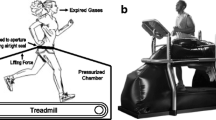Abstract
Purpose
Body weight-supported treadmill training using positive air pressure has become increasingly popular, but little is known about the metabolic adaptations to these treadmills. This study aimed to evaluate the existence and length of a metabolic accommodation period to running on a lower body positive pressure (LBPP) treadmill.
Methods
A total of eight recreational runners (5 males and 3 females) ran 15 min trials (5 min at 50, 70, and 90 % body weight) on the AlterG Anti-gravity® P200 treadmill. No verbal instruction was given on how to run on the device. Their trial pace corresponded to 70–80 % of their velocity measured at \(\dot{V}\)O2max on a standard treadmill. Trials were continued until no significant metabolic change was observed. Two-way repeated measures analysis of variance was used to analyze changes in \(\dot{V}\)O2 across trials and levels of unloading.
Results
Participants completed 7 trials. Comparing trial 1 to the average of trials 5, 6, and 7, \(\dot{V}\)O2 decreased from 29.6 ± 3.8 to 23.6 ± 4.4 ml/kg/min at 50 % body weight (~20 % reduction), from 33.7 ± 4.5 to 29.2 ± 5.1 ml/kg/min at 70 % body weight (~13 % reduction), and from 41.0 ± 7.7 to 36.6 ± 5.6 ml/kg/min at 90 % body weight (~11 % reduction). No significant reduction occurred after trial 4 at any level of support.
Conclusions
An accommodation effect of running on a treadmill with LBPP was observed and reached after 60 min of running (4 trials of 15 min). The accommodation effect was the largest at the greatest level of body weight support. These data suggest the importance of an accommodation period for reliable measures of metabolic cost to be made.

Similar content being viewed by others
Abbreviations
- BW:
-
Body weight
- BWS:
-
Body weight support
- LBPP:
-
Lower body positive pressure
- ANOVA:
-
Analysis of variance
References
Bijker KE. (2003) Metabolic cost of running and walking. PhD thesis, Free University, Amsterdam, The Netherlands
Burleson C, Craib MW, Filarski K, Jordan S, Krahenbuhl GS, Morgan DW (1994) Daily variability in running economy among well-trained male & female distance runners. Res Q Exerc Sport 65:72
Farley CT, McMahon TA (1992) Energetics of walking and running: insights from simulated reduced-gravity experiments. J Appl Physiol 73:2709–2712
Grabowski AM, Kram R (2008) Effects of velocity and weight support on ground reaction forces and metabolic power during running. J Appl Biomech 24:288–297
Morgan DW, Craib M (1992) Physiological aspects of running economy. Med Sci Sports Exerc 24:456–461
Morgan DW, Martin PE, Krahenbuhl GS, Baldini FD (1991) Variability in running economy and mechanics among trained male runners. Med Sci Sports Exerc 23:378–383
Pearson KG (2000) Neural adaptation in the generation of rhythmic behavior. Annu Rev Physiol 62:723–753
Schieb DA (1986) Kinematic accommodation of novice treadmill runners. Res Q Exerc Sport 57(1):1–7
Teunissen LPJ, Grabowski AM, Kram R (2007) Effects of independently altering body weight and body mass on the metabolic cost of running. J Exp Biol 210:4418–4427
Van Ingen Schenau CJ (1980) Some fundamental aspects of the biomechanics of overground versus treadmill locomotion. Med Sci Sports Exerc 12:257–261
Wall JC, Charteris J (1982) A kinematic study of long-term habituation to treadmill walking. Ergonomics 24:531–542
Acknowledgments
The current study was made possible by funding from the Technology Research Initiative Fund (TRIF) at Northern Arizona University for purchase of the AlterG® Anti-Gravity treadmill®.
Conflict of interest
The authors declare no conflict of interest.
Author information
Authors and Affiliations
Corresponding author
Additional information
Communicated by Peter Krustrup.
Rights and permissions
About this article
Cite this article
McNeill, D.K.P., de Heer, H.D., Williams, C.P. et al. Metabolic accommodation to running on a body weight-supported treadmill. Eur J Appl Physiol 115, 905–910 (2015). https://doi.org/10.1007/s00421-014-3071-y
Received:
Accepted:
Published:
Issue Date:
DOI: https://doi.org/10.1007/s00421-014-3071-y




